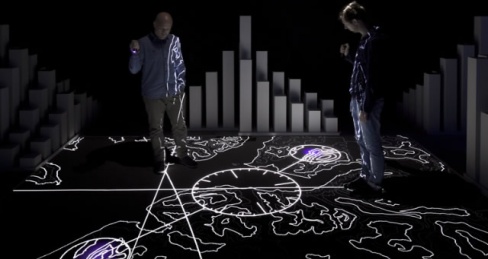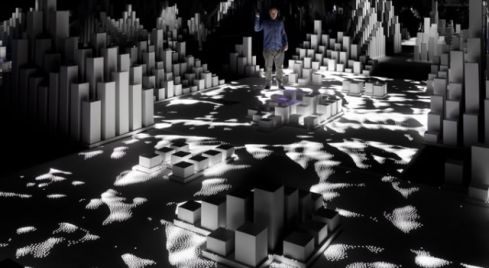About High Arctic (taken from the nmm.ac.uk website) with shakey cam taken by me.... cant copy and paste in a referencing manner so take this shit out
In July 2011 the National Maritime Museum, in collaboration with United Visual Artists (UVA) and Cape Farewell, presents High Arctic. It is the first exhibition in the NMM’s new Sammy Ofer Wing, a major capital project which enables the organisation to present its exhibitions in an entirely new way.
It’s 2100 AD and the Arctic landscape we once took for granted has changed forever. How will we choose to remember our Arctic past? Is it possible to travel somewhere that no longer exists? Set in one of many possible futures High Arctic conveys the scale, beauty and fragility of our unique Arctic environment through an immersive installation which fills the entire 820m2 gallery space. Intended to be a future vision of a receding world, it encourages us to question our relationship with the world around us.
In September 2010 UVA’s Matt Clark travelled with the arts and climate science foundation Cape Farewell to the Arctic archipelago of Svalbard, which lies between mainland Norway and the North Pole. Sailing aboard The Noorderlicht, a 100-year old Dutch schooner, Matt’s trip brought him into contact with scientists, poets, musicians and polar bears. He saw vast tundra, monochromatic rainbows and huge chunks of ice falling from calving glaciers. Conceived as a response to the expedition, High Arctic uses a combination of sound, light and sculptural forms to create an abstracted arctic landscape for visitors to explore.



You interacted with the installation using a UV lighted torch which i presume was monitored using a UV sensitive camera to relay onto the programmed installations...
pointing the light and some objects such as the blocked "icebergs" would produce another box appearing with you could break up into tringles. depicting the melting of the ice caps.
Braid is a 2D platformer released for all the major computing platforms. it stands out in todays gaming market for its narrative technique and interactivity. allowing you to control time such as if you die you can turn back time to a point you are living. you use these techniques to solve puzzles and collect keys to allow you to continue the story.
(trailer left)
Limbo is another 2D platformer that has no for of narrative apart from the journey you encounter through your gameplay.
using a very minimilistic graphic style of black and white with an overlay of film grain, it creates a very erie atmosphere to the game.
again the trailer is to the bottom left. it was released for PS3 and Xbox 360
The Fantastic Flying Books of Mr. Morris Lessmore is an interactive book made for the Apple Ipad wich lets you further the story through interaction with cut scenes and puzzles through out the story. less gamey and more digital story.
made by moonbot studios and animated by William Joyce of Pixar fame (trailer to the left)
The Infinite Adventure Machine made by david benque is a prototype application developed to create an endless collection of images that the user can use to help improvise a story to tell to a small child for example. the user only interacts with a touch to bring up the next picture but the creation is more natural. this could be seen as more of a tool etc...
Shadow of the Colossus was released for the Playstation 2 in 2004 and later re-released for the PS3 in 2011. its narrative style is simple and uses very minimal spoken/written narrative to continue the story. instead your left to figure out whats happening through your own actions and feelings...(trailer to the left)
An exhibition with no touchscreens, no static photographs, and no panels with text: instead High Arctic is a genuinely immersive, responsive environment. Ultraviolet torches unlock hidden elements, constantly shifting patterns of graphics and text that react to visitors approaching; an archipelago of thousands of columns fills the gallery space, each representing a real glacier in Svalbard; an artificial horizon borders the gallery as a seamless canvas of light, shifting in intensity and colour. A Max Eastley and Henrik Ekeus-designed generative soundscape flows through the gallery, weaving in the voices of arctic explorers across the centuries as well as the poetry of Nick Drake who travelled with Matt to Svalbard.
High Arctic is the first time UVA have taken on a commission of this size and scale in the UK and is the first time the NMM has showcased a work of this kind. UVA are an award-winning art and design practice who work at the intersection of sculpture, architecture, live performance, moving image and digital installation; with expertise in fine art, architecture, communication design, moving image, computer science and engineering. UVA’s work has been exhibited at institutions including the V&A, the Royal Academy of Art, the Southbank Centre, the Wellcome Collection, Opera North Leeds, Durham Cathedral and The British Library. Cape Farewell’s aim is to inspire a cultural response to the climate challenge and engage artists as catalysts to provoke a cultural shift towards sustainable society. Other artists that have been engaged in the Cape Farewell programme include Antony Gormley, Jarvis Cocker and Ian McEwan – whose recent novel Solar was inspired by the 2005 Cape Farewell Arctic expedition.
